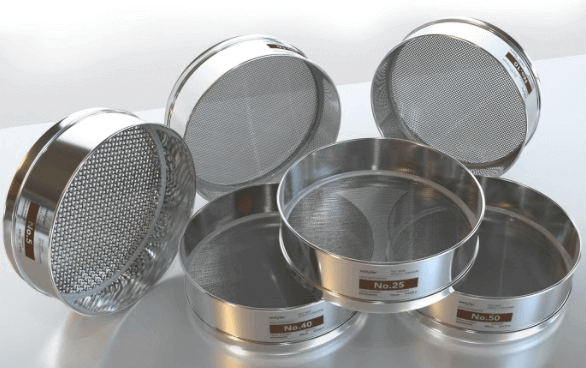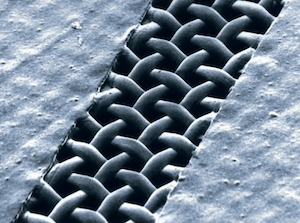Woven vs. Welded Wire Mesh
Plastic extrusion, pharmaceutical drugs, roadways, and high-rise apartments. These are just a few of the many industries that thrive when mesh is properly integrated.
With dozens of mesh solutions, such as woven wire mesh and welded mesh, on the market, it’s up to the engineers, project managers, and lab technicians to select the right one.
But which material works best: welded mesh or woven wire mesh?
“What will the mesh be used for? What material am I working with? When do I need the mesh?” are all questions you must ask yourself when determining whether to use welded mesh or woven wire mesh.
W.S. Tyler has been a leading wire mesh manufacturer for over 140 years and are here to ensure you integrate the right mesh solution.
This article will establish what welded mesh and woven wire mesh are, how each material is made, what they are used for, and how they compare in cost. At the end, you should have a better understanding of which mesh will work for you.
What Is Woven Wire Mesh?
 Woven wire mesh is best described as a predetermined number of metal wires interlaced together to form a roll or sheet of wire cloth that upholds a specific pattern. When weaving mesh, parameters such as wire diameter, opening (aperture) size, micron rating, weave pattern, width, and length can be customized to your specific needs.
Woven wire mesh is best described as a predetermined number of metal wires interlaced together to form a roll or sheet of wire cloth that upholds a specific pattern. When weaving mesh, parameters such as wire diameter, opening (aperture) size, micron rating, weave pattern, width, and length can be customized to your specific needs.
How Is Woven Wire Mesh Woven?
When woven wire mesh is woven, a designated amount of wires are wrapped around a warp beam that gets placed into a specialized weaving loom. The warp wires are then placed into heddle frames that split them into 2 or more sets depending on the weave/pattern of the mesh.
As the loom operates, the heddle frames push the different sets of wires up and down as a wire, known as the shute wire, is driven in between the wires. After being threaded through the wires, the up and down motion of the heddle frames locks the shute wire into place.
Applications
One advantage woven wire mesh has over welded mesh is that the mesh opening can be much finer. This is because as the wire diameter gets smaller, the harder it is to weld the mesh without damaging the wires or compromising the openings of the mesh.
 |  | 
|
Having said that, the finer mesh openings of woven wire mesh makes it perfect for virtually any filtration, particle analysis, or screen printing application.
What Is Welded Wire Mesh?
Welded wire mesh is a series of steel wires that are welded at the wire cross-sections using one of several welding techniques, most commonly TIG and spot welding. As the wires undergo a thorough welding process, the opening size of the mesh is, for the most part, permanent.
How Is Welded Wire Mesh Made?
When welded wire mesh is made, spools of wires are threaded into a weld mesh machine, much like threading wires into the heddle frames and reed of a woven wire loom. Separate spools of wire are then fed through a straightener and pre-cut to match the desired width of the mesh.
As the machine runs, the wires from the spools are fed through the machine. The pre-cut wires are then placed into a mechanism that lays them across the wires being fed from the spools.
After being laid in place, the machine applies a uniform weld at each cross-section simultaneously. Depending on the length of the welded wire mesh fabric, the mesh is made available in welded wire mesh rolls or operators take the mesh, cut the access material, and place it into piles of welded wire mesh panels with a predetermined size.
Applications
As thicker wires must be used to withstand the welding process, welded wire mesh is regarded as being the more rigid and durable of the two materials. This heightened strength makes it perfect for perimeter fencing, protective caging (animals and equipment), and concrete wire mesh sheets.
How Does Cost Compare Between Woven and Welded Wire Mesh?
As illustrated previously, welded mesh and woven wire mesh are produced differently. That said, other than the threaded wires throughout the loom, the weaving process of woven wire is mostly automated.
Producing welded mesh, on the other hand, is a lot more hands-on. An operator must thread wire through a straightener before it is cut into the crossbars.
Additional wire must also be threaded through the machinery itself.
Now, the mechanism that accurately places the crossbars must constantly be fed material. These bars are commonly fed by hand.
Lastly, the access material that protrudes off the edges must ensure optimal results. Again this process is commonly done manually when the mesh is not being rolled by the machine.
With that, the labor costs and heavy-duty wire that must be used causes welded mesh to be the more costly of the two.
Which Mesh Is Right For Me?
As with all mesh solutions, the application will determine whether you should use welded mesh or woven wire mesh.
If you are working with rugged material that requires a mesh that is sturdy and durable, welded wire mesh may be a good fit. Welded mesh is also a good fit for extremely corrosive conditions as it can be galvanized for extra protection.
If mesh strength is not an issue and you’re looking for a cost-effective mesh solution that can offer smaller mesh openings than ¼” for filtration purposes, woven wire mesh is right for you. As woven wire mesh is produced predominantly with stainless steel, which is too resistant to corrosive material, the fact that it often has shorter lead times than welded mesh should also be considered.
Implement the Ideal Mesh Specification
At first glance, woven wire mesh and welded may seem identical, however, they are two materials that carry a lot of differences. That said, no matter which mesh you chose to implement, knowing the right mesh specification is just as important as the material itself.
Woven wire mesh is a series of wire interlocked together during the weaving process and is ideal for filtration, particle analysis, and screen printing.
Welded mesh is a mesh sheet that is welded at each cross-section and is ideal when heavy-duty mesh openings are needed.
Having worked with woven wire mesh for over 140 years, W.S. Tyler has the know-how needed to ensure your mesh solution properly process your material.
Review our article How to Pick the Right Woven Wire Mesh (Mesh Count, Wire Diameter, and Micron Rating) to gain a better understanding of which mesh specifications work best for you.
WHAT IS WIRE MESH?
Wire mesh, which is also referred to as wire cloth or wire fabric, is an extremely versatile product that has thousands of different applications throughout the world. What makes wire mesh such an adaptable product is that is can be produced in a countless number of specifications. Depending upon manufacturing capabilities, there are almost endless combinations of opening sizes and diameter wires that can be produced, either in a woven or welded construction.
Wire mesh is commonly used in industrial applications when separation or filtration is needed; it is also popular for use in commercial applications, like insect screening or animal fencing. More widespread applications for wire mesh include: various types of security mesh, like window, machine and stairwell panel guards, fireplace screen, bird screen, gutter guards, ventilation and RFI shielding. More recently, wire mesh has emerged into the architectural field and the art scene.
Edward J. Darby & Son, Inc. prides itself on maintaining one of the most complete and extensive wire mesh inventories in the United States. Darby weaves, welds and stocks thousands of different wire mesh specifications including: woven and welded wire mesh, space (clear opening) wire cloth, standard or market grade, milling grade, and bolting grade.
In our 160 plus years of an industry leader, Edward J. Darby & Son, Inc. has supplied wire mesh to a broad range of industries and fields including: agricultural, automotive, biometrics, building & construction products, chemical, coal, electronic, food, glass, heat treating, insulation, machining, mining, oil and oil refining, plastics, pharmaceuticals, rubber, textile and tobacco.
This website includes two very important sections to better familiarize the visitor to the nuts and bolts of the wire mesh industry. Our Wire Mesh Glossary contains definitions and explanations of key terms and concepts; important information related to common Metals & Alloys is also worth exploring.




评论
发表评论